

Winter Camping Boots and Footwear: Insulation, Waterproofing, Traction Guide
by
Emily Wychwood
When selecting winter camping boots and footwear, it’s essential to prioritize insulation, waterproofing, and traction for comfort and safety in cold conditions. Consider insulation type and thickness based on activity level and weather, ensuring boots are waterproof and offer effective traction on icy surfaces. Also, pay attention to boot height for snow protection and choose a pair that provides a good fit, considering weight and design for mobility.
Winter camping requires specialized boots and footwear that provide insulation, waterproofing, and traction to keep your feet warm and safe in extreme cold. When choosing the right winter camping boots, it’s important to consider various factors to ensure maximum comfort and protection.
Key Takeaways:
- Choose boots based on the intended use – casual wear or rigorous outdoor activities like winter hiking.
- Insulation options range from 200-gram to 1,200-gram, with synthetic insulation offering water resistance and insulation even when wet.
- Consider boot height for snow and ice protection, with taller boots providing more coverage.
- Look for stylish options that perform well in outdoor activities and align with personal style preferences.
- Traction is crucial, with specialized lug patterns and rubber compounds designed to prevent slippage on slick surfaces.
Consider two-piece designs for better waterproofing and cushioning, while one-piece designs are lighter and more suitable for active use. Pay attention to boot height and tongue design for effective waterproofing.
Weight and bulk should also be considered, with lightweight options being more suitable for active use. Lastly, prioritize finding boots that fit well, allowing for toe wiggle room without causing discomfort or rubbing.
By considering these factors and key takeaways, you can find the perfect winter camping boots and footwear that offer the right insulation, waterproofing, and traction for your outdoor adventures.
Factors to Consider When Choosing Winter Camping Boots
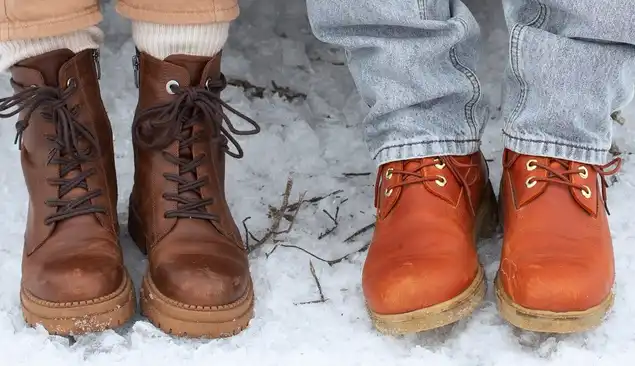
When choosing winter camping boots, it’s crucial to consider factors such as insulation, waterproofing, and traction to ensure maximum comfort and protection in cold weather. Whether you’re planning a casual winter outing or embarking on a challenging winter hike, selecting the right boots is essential for a safe and enjoyable experience.
Insulation
Insulation plays a vital role in keeping your feet warm in cold temperatures. Synthetic insulation is a popular choice for winter boots as it offers excellent water resistance and insulation even when wet. The insulation thickness can range from 200-gram to 1,200-gram, with the appropriate level depending on your activity level, circulation, sock type, and fit. Consider your specific needs and the expected weather conditions when selecting the insulation type and thickness for your winter camping boots.
Waterproofing
Winter camping often involves encounters with snow, slush, and wet terrain, making waterproofing an essential feature in boots. There are two types of designs to consider: two-piece and one-piece. Two-piece boots feature a removable liner, offering superior waterproofing and more cushioning. On the other hand, one-piece boots are lighter and more suitable for active use. Pay attention to the boot height and tongue design to prevent water and snow from entering. Adequate waterproofing will keep your feet dry and comfortable throughout your winter camping adventures.
Traction
Good traction is essential for maintaining stability and preventing slips and falls on icy or slippery surfaces. Different lug patterns and rubber compounds are designed to enhance grip and provide traction on slick terrains. Consider the intended use of your winter camping boots to select the appropriate level of traction. Boots designed for hiking typically offer more traction than casual styles. If you frequently encounter icy conditions, look for specialized technologies that offer enhanced grip on ice. Prioritizing traction will ensure you stay safe and steady on your winter camping expeditions.
| Factors to Consider | Insulation | Waterproofing | Traction |
|---|---|---|---|
| Importance | Keeps feet warm | Keeps feet dry | Prevents slips and falls |
| Types | Synthetic insulation | Two-piece and one-piece designs | Different lug patterns and rubber compounds |
| Considerations | Activity level, circulation, sock type, and fit | Boot height and tongue design | Intended use and specialized technologies |
By carefully considering the insulation, waterproofing, and traction of winter camping boots, you can select the perfect pair that meets your specific needs. Don’t forget to prioritize factors like fit, boot height, and weight as well. With the right boots, you’ll be ready to conquer the winter outdoors comfortably and confidently.
Insulation Options for Winter Camping Boots
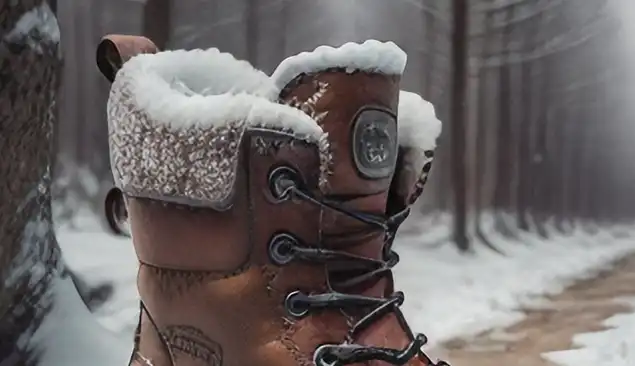
The insulation of winter camping boots is a vital factor in keeping your feet warm, and there are different options available, ranging from synthetic insulation to various thicknesses. Synthetic insulation is a popular choice as it provides both water resistance and insulation, even when wet. This type of insulation is commonly used in winter boots due to its ability to retain warmth and durability.
When it comes to insulation thickness, options range from 200-gram to 1,200-gram, giving you the flexibility to choose the right level of warmth based on your needs. The thickness of the insulation can vary between different boot models, so it’s important to consider your intended use and the expected weather conditions when selecting the appropriate insulation level.
In addition to synthetic insulation, there are also boots available with other insulation materials such as down and wool. Down insulation offers excellent warmth, but it may lose its insulating properties when wet. Wool, on the other hand, is a natural insulator that provides warmth even when damp. It is known for its breathability and moisture-wicking properties, making it a great choice for winter camping boots.
| Insulation Type | Properties |
|---|---|
| Synthetic | Water-resistant, insulates even when wet, durable |
| Down | Excellent warmth, may lose insulation when wet |
| Wool | Natural insulator, provides warmth even when damp, breathable |
When selecting winter camping boots, consider the insulation options available and choose the one that best suits your needs in terms of warmth, weather conditions, and personal preferences. With the right insulation, your feet will stay snug and comfortable during your winter adventures.
Boot Height and Its Importance in Winter Camping

The height of winter camping boots plays a crucial role in keeping snow and ice out, providing necessary protection in cold and snowy conditions. When selecting winter boots for camping or outdoor activities, it is important to consider the intended use and personal preference for boot height.
Boot shafts typically measure between 6 to 15 inches, with taller boots offering more protection in deep snow. For those venturing into areas with heavy snowfall or challenging terrain, taller boots are recommended as they provide better coverage and prevent snow from entering the boots.
In addition to keeping snow out, taller boots also offer added ankle support, which is beneficial when navigating uneven or slippery surfaces. Furthermore, the height of the boots can also contribute to overall warmth. Higher boots cover a larger portion of the leg, thereby providing an extra layer of insulation against the cold.
| Boot Height | Recommended Use |
|---|---|
| 6-8 inches | Ideal for casual winter wear and light outdoor activities |
| 8-10 inches | Suitable for moderate outdoor activities and short hikes |
| 10-15 inches | Recommended for winter camping, hiking in deep snow, and extreme weather conditions |
When choosing winter camping boots, it is essential to consider the appropriate boot height that aligns with the planned activities and the level of protection required. By selecting the right boot height, individuals can ensure their feet stay warm, dry, and comfortable throughout their winter camping adventures.
Traction Technology for Winter Camping Boots
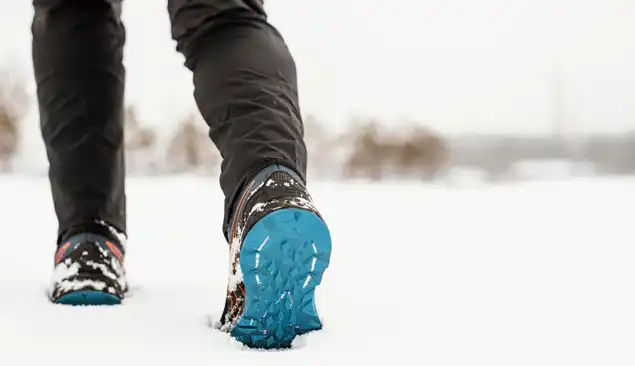
Traction is a crucial feature in winter camping boots, and there are various technologies available, such as different lug patterns and rubber compounds, designed to provide enhanced grip on slippery surfaces. These technologies help prevent slippage on ice and snow, ensuring stability and safety during outdoor activities in winter conditions.
When it comes to lug patterns, deeper and more aggressive lugs offer better traction on snow and ice. They provide increased surface area contact, digging into the terrain and providing a secure grip. Lug patterns with multidirectional designs are especially effective, as they provide grip in various directions, allowing for better maneuverability on different surfaces.
Rubber compounds also play a significant role in traction technology. Many winter boots feature specialized rubber compounds that remain flexible even in freezing temperatures. These compounds are engineered to provide optimal grip and prevent slipping on icy surfaces. Some boots even incorporate sticky rubber compounds that offer superior traction on wet ice.
| Lug Pattern | Traction Level |
|---|---|
| Deep, aggressive lugs | High |
| Multidirectional lug patterns | High |
| Specialized rubber compounds | High |
| Sticky rubber compounds | High |
By considering the lug patterns and rubber compounds used in winter camping boots, individuals can select a pair that offers the enhanced grip needed for their specific activities. Whether hiking through snowy trails or navigating slippery icy surfaces, having reliable traction technology in winter boots is essential for a safe and enjoyable outdoor experience.
Waterproofing Capabilities of Winter Camping Boots
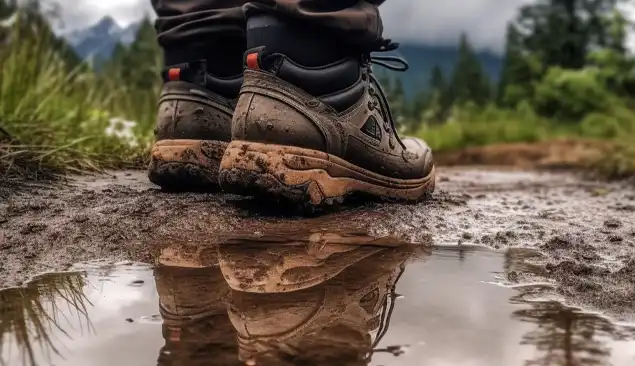
Waterproofing is an essential feature in winter camping boots, and different designs offer varying levels of waterproof capabilities, including one-piece and two-piece options. Two-piece designs, featuring a removable liner, offer better waterproofing and more cushioning. They are ideal for extended outdoor use and provide excellent protection against moisture. On the other hand, one-piece designs are lighter and more suitable for active use, making them a popular choice among winter hikers and adventurers.
To ensure maximum waterproofing performance, it is crucial to consider the boot height and tongue design. Higher boot heights provide better protection against snow and water ingress, keeping your feet dry and warm even in deep snow. Additionally, boots with well-designed tongues that are integrated into the upper offer enhanced waterproofing capabilities, preventing water and snow from seeping into the boots.
When selecting winter camping boots, it’s important to choose a pair with the right combination of waterproof materials and construction. Look for boots made with waterproof membranes like GORE-TEX, which effectively repel water while allowing moisture vapor to escape, keeping your feet dry and comfortable. These membranes are integrated into the boot’s upper and provide reliable waterproofing in various winter conditions.
| Boot Design | Waterproof Capability | Best Use |
|---|---|---|
| One-Piece Design | Lightweight | Active use, winter hiking |
| Two-Piece Design | Superior waterproofing | Extended outdoor use, extreme weather conditions |
In conclusion, waterproofing is a crucial feature to consider when choosing winter camping boots. With various designs available, such as one-piece and two-piece options, it is essential to select boots that provide the desired level of waterproof capabilities based on your specific needs and outdoor activities. By ensuring effective waterproofing, you can enjoy winter camping with confidence, knowing that your feet will stay dry and comfortable throughout your adventures.
Weight and Bulk Considerations for Winter Camping Boots

The weight and bulk of winter camping boots should be considered, with lightweight options being more suitable for active use during winter camping activities. When venturing into the outdoors in winter conditions, it’s important to have footwear that won’t weigh you down or impede your movements. Heavy and bulky boots can make it difficult to navigate through snow and ice, leading to fatigue and discomfort.
To ensure a more enjoyable and comfortable experience, it’s worth investing in lightweight winter camping boots. These boots are designed to provide the necessary protection and insulation without sacrificing mobility. With advancements in technology and material, manufacturers are able to create boots that are both lightweight and durable, allowing you to move freely while still keeping your feet warm and protected.
Lightweight winter camping boots are often made with materials such as synthetic fabrics and lightweight insulation, reducing the overall weight without compromising on warmth. These boots typically have a streamlined design, employing innovative construction techniques to minimize bulk while maximizing performance.
When choosing winter camping boots, take into account the activities you plan to engage in and the terrain you’ll be traversing. If you’ll be embarking on long hikes or trekking through challenging terrain, opting for lightweight boots can make a significant difference in your overall comfort and endurance. Remember, every ounce makes a difference, so choose boots that strike the right balance between weight, insulation, and protection.
Finding the Right Fit for Winter Camping Boots
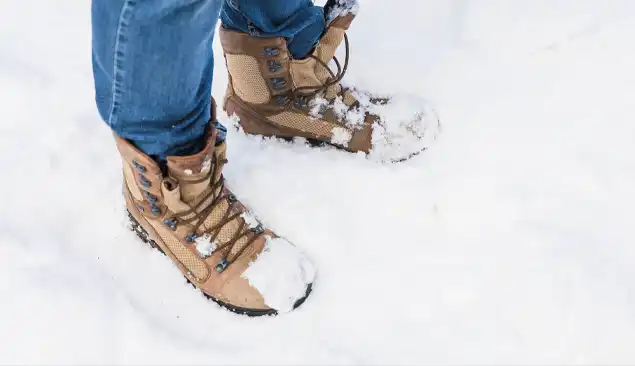
Choosing winter camping boots that fit well is essential for comfort and preventing discomfort or rubbing, so it’s important to find the right fit for your feet. Here are some key considerations to keep in mind:
- Measure your feet: Start by measuring your feet accurately. Use a tape measure or ruler to measure the length and width of your feet to determine your shoe size. Keep in mind that different brands may have slightly different sizing, so always refer to the brand’s specific size chart.
- Consider your foot shape: Everyone’s feet are different, so it’s important to find boots that accommodate your foot shape. Some brands offer different width options, such as wide or narrow, to ensure a proper fit. If you have specific foot concerns, such as high arches or wide feet, look for boots that provide additional support or room in those areas.
- Try them on with appropriate socks: When trying on winter camping boots, wear the type of socks you plan to wear during outdoor activities. This will ensure a more accurate fit. Additionally, consider the thickness of the socks and how they might affect the fit. If you plan to wear thick winter socks, make sure the boots have enough room to accommodate them without pinching or squeezing your feet.
- Pay attention to the toe box and heel: The toe box should provide enough room for your toes to move comfortably without feeling cramped. Make sure there is sufficient space at the front of the boot to wiggle your toes. Additionally, check that the heel fits snugly without slipping or rubbing against the back of the boot.
Remember, a proper fit means that your feet should feel supported, comfortable, and secure in the boots. Try walking around in them to assess how they feel and make any necessary adjustments. Taking the time to find winter camping boots that fit well will ensure a more enjoyable and hassle-free outdoor experience in cold weather conditions.
In summary, finding winter camping boots that fit well involves measuring your feet accurately, considering your foot shape, trying them on with appropriate socks, and paying attention to the toe box and heel. By following these guidelines, you can ensure a comfortable and proper fit, allowing you to fully enjoy your winter camping adventures.
Summary of Choosing Winter Camping Boots and Footwear
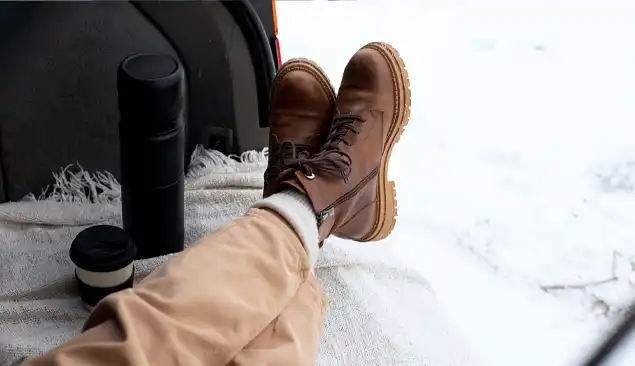
To ensure comfort, warmth, and protection during winter camping, it’s crucial to consider factors such as insulation, waterproofing, and traction when selecting the right boots and footwear. When choosing winter camping boots, the intended use should be determined. Casual winter boots are stylish and offer decent grip and insulation, while serious boots provide better protection for harsh weather and extended outdoor use.
The warmth of winter boots is essential, and besides temperature ratings, factors like activity level, circulation, sock type, and fit also play a role. Synthetic insulation is common and offers water resistance and insulation even when wet. Insulation options vary from 200-gram to 1,200-gram, with different models featuring varying types and thicknesses.
Boot height is important for keeping snow and ice out, and the choice should depend on the intended use and personal preference. Taller boots provide more protection in deep snow, with shafts typically measuring between 6 to 15 inches.
Styling is also a consideration, as winter boots are worn for various purposes, including hiking and city wear. Many brands now offer stylish options that perform well in outdoor activities.
| Factor | Description |
|---|---|
| Traction | Different lug patterns and rubber compounds designed to prevent slippage on slick surfaces |
| Waterproofing | Two-piece designs offer better waterproofing and more cushioning, while one-piece designs are lighter and more suitable for active use |
| Weight and Bulk | Lightweight options are more suitable for active use |
| Fit | Choose boots that fit well, allowing for toe wiggle room and avoiding discomfort or rubbing |
In summary, when choosing winter camping boots and footwear, it is important to consider factors such as use, warmth, boot height, traction, insulation type, waterproofing, weight, and fit. By considering these factors, individuals can find boots that suit their specific needs and provide comfort, warmth, and protection during winter camping activities.
Conclusion
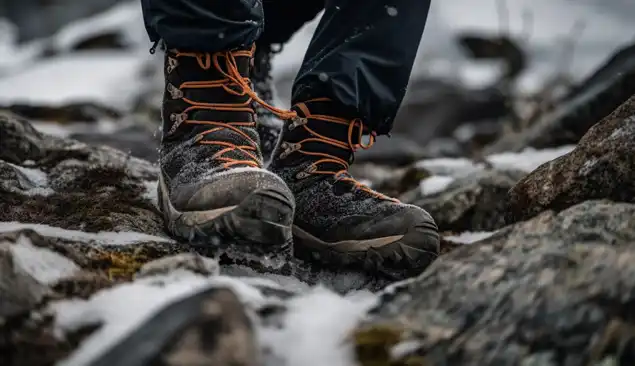
Choosing the right winter camping boots and footwear is crucial for keeping your feet comfortable, warm, and protected during outdoor winter activities. When selecting your winter boots, it’s important to consider various factors to ensure you find the perfect pair that suits your needs.
Firstly, determine the intended use of the boots. If you’re looking for casual wear, stylish winter boots with decent insulation and grip may be suitable. However, if you plan to engage in more rigorous outdoor activities like winter hiking, opt for boots that provide better protection in harsh weather conditions.
Warmth is a key consideration, and aside from temperature ratings, factors such as activity level, circulation, sock type, and fit also play a role. Synthetic insulation is a common option, offering water resistance and insulation even when wet, with insulation options ranging from 200-gram to 1,200-gram.
Boot height is important for keeping snow and ice out, so choose a height that aligns with your intended use and personal preference. Whether you opt for a 6-inch shaft or a taller design, ensure it provides the necessary protection in deep snow.
Traction is crucial for winter boots, especially on slick surfaces. Different lug patterns and rubber compounds are designed to prevent slippage, with specialized technologies available for enhanced grip on ice. Consider your needs and choose boots with appropriate traction depending on your activities.
Waterproofing capabilities should also be taken into account. Two-piece designs with a removable liner offer better waterproofing and more cushioning, while one-piece designs are lighter and more suitable for active use. Pay attention to boot height and tongue design to ensure water and snow stay out.
Weight and bulk should be considered, especially if you plan on being active in your winter boots. Lightweight options are ideal for minimizing fatigue and allowing for ease of movement. Finally, finding the right fit is crucial for comfort and avoiding discomfort or rubbing. Ensure there is enough wiggle room for your toes without compromising the fit.
In summary, when choosing winter camping boots and footwear, consider factors such as use, warmth, boot height, traction, insulation type, waterproofing, weight, and fit. By carefully considering these factors, you can find boots that meet your specific needs and provide the utmost comfort, warmth, and protection during your winter camping adventures.
FAQ
A: When choosing winter camping boots, consider factors such as use, warmth, boot height, traction, insulation type, waterproofing, weight, and fit.
A: Insulation is crucial in winter boots as it provides warmth. Factors such as temperature ratings, activity level, circulation, sock type, and fit also play a role in determining the warmth of the boots.
A: Traction is crucial in winter boots to prevent slippage on slick surfaces. Different lug patterns and rubber compounds are designed to enhance grip, with specialized technologies available for enhanced grip on ice.
A: While not all winter boots are waterproof, it is important to consider their waterproofing capabilities. Two-piece designs with removable liners often offer better waterproofing, and attention should be paid to the boot height and tongue design to prevent water and snow from entering.
A: Finding the right fit in winter boots is important for comfort and to avoid discomfort or rubbing. Boots should allow some wiggle room for the toes and should fit well without causing any discomfort.
A: The key factors to consider when choosing winter camping boots and footwear are insulation, waterproofing, traction, boot height, styling, weight and bulk, and finding the right fit. These factors will determine the comfort, warmth, and protection provided during winter camping activities.
A: Finding the right fit in winter boots is important for comfort and to avoid discomfort or rubbing. Boots should allow some wiggle room for the toes and should fit well without causing any discomfort.
Author

Emily Wychwood
Emily is an avid camper and outdoors enthusiast, with a passion for exploring new places and trying out new gear. She grew up camping with her family and has continued the tradition with her own children, who love nothing more than roasting marshmallows around the campfire.
Recent Posts


